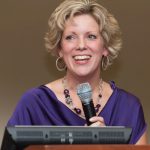
Our Story: From Humble Beginnings to a Thriving Program
By: Aubrey Abbott Patterson (’98)
 When I think about why I support the Staley School of Leadership Studies, I can’t help but think back to my time at K-State — when the program itself was still an idea, a vision of what could be.
When I think about why I support the Staley School of Leadership Studies, I can’t help but think back to my time at K-State — when the program itself was still an idea, a vision of what could be.
As part of the 20th Anniversary Engagement Committee, I’m thrilled to have the opportunity to reconnect with the work of the School and engage with the many students, alumni, faculty, and staff who have helped make it what it is today. But I was never more struck with the full gravity of what it means for this program to be 20 years old, until I recently read a note from one of the School’s visionary founders, Dr. Bob Shoop. As always, Dr. Shoop’s words got me thinking, and I wanted to share them with you to think about as well.
“Over 20 years ago, Dr. Susan Scott and I begin talking with each other about leadership. We each had been involved in teaching and doing research in the area of leadership for several years. We wondered if it would be possible to develop a learning community that was research-based, student centered, and service oriented. We knew that there were other places on campus that focused on teaching various aspects of leading. However, we were interested in asking and answering the question, “leading for what purpose?” As with any new program, there were significant issues of tradition, turf, and threat that had to be addressed. We worked almost daily to educate university administrators, faculty, and later the Kansas Board of Regents (and even later still, donors) about the unique program that we envisioned. We put a lot of thought into our mission statement and each word was very carefully selected. Obviously, we were concerned that all teaching was based on solid research. For me, the most important aspect of our experiment was to see if ethical decision-making could be taught. We believed that caring for colleagues, clients, and constituents was critical to any leadership task. And both Susan and I had been committed to equity and diversity since very early in our careers.
Honestly, the first few years were magical. We were able to enroll the significant leaders in the college of education and the University. The students who enrolled in the early coursework were incredibly enthusiastic, creative, and dedicated. Much of the early design was modified as a result of input from these early students.” –Dr. Bob Shoop
After reading this, I began reflecting on exactly the types of conversations he described. As a student in 1997, I recall a day in Women in Leadership class where Susan essentially pitched this idea to us. We then walked across Manhattan Avenue to an empty house, that we learned could be the first home of leadership studies at Kansas State University. I can still remember how it felt that day, sitting in a circle on the wooden floor of that empty living room, and thinking, talking, and dreaming about what could be.
The process for how this program came to fruition was, in many ways, the first opportunity to model the type of leadership that we hoped it would instill in future students. It was personal, relational, and wholly focused on students and the leadership they wanted to exercise in our communities and our world. I continually draw from the lessons I learned during this exciting and transformational period of my life, and I know that I’m not alone in feeling a deep sense of connection to both K-State and leadership studies.
Dr. Shoop’s note concluded with this: “Having been away from the program for a time, I think I have a pretty objective lens with which to observe what it is doing now. I am incredibly proud of what leadership studies has become. The administration and faculty of the program are actualizing the vision that Susan and I developed. And, as the program grows and develops, it will hopefully continue to reinvent itself to continually be responsive to the needs of the students and the larger community.”
This 20th Anniversary has been a wonderful opportunity to check back in with what is now the Staley School of Leadership Studies. And the thing I find to be most remarkable is the fact that, when I’m there today, I can tell the students feel the same way about the program as I did when I was at K-State. I’m amazed and inspired by all the ways the School has grown and changed, but I was not surprised at all to discover that the culture is exactly as I remember it: caring, student-centered, and mission-driven.
Though the program reaches many more students than it did during my time there, it remains a tight-knit and future-focused learning community. I gained so much from this environment and have been forever impacted by the learning and relationships that I developed; I truly believe that I’m a better leader and a better person because of my time in K-State’s leadership studies program. And when I see that same passion and motivation in today’s students, I can’t help but think—and dream—about what the next 20 years might have in store for the leaders of the future.
Always a Wildcat,
Aubrey Abbott Patterson (’98)
P.S. I hope you’ll take opportunities to engage with the Staley School throughout this celebratory year! One way I enjoy doing this, which was most certainly not available in 1998, is social media. Stay in touch on Facebook, Twitter, Instagram, LinkedIn, and on their new blog, “The Loop!“

